
Entomology is the scientific study of insects, a branch of zoology. In the past the term insect was less specific, and historically the definition of entomology would also include the study of animals in other arthropod groups, such as arachnids, myriapods, and crustaceans. This wider meaning may still be encountered in informal use. The field is also referred to as insectology in American English, while in British English insectology implies the study of the relationships between insects and humans.
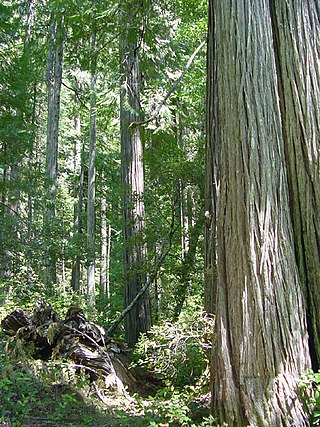
Chamaecyparis lawsoniana, known as Port Orford cedar or Lawson cypress, is a species of conifer in the genus Chamaecyparis, family Cupressaceae. It is native to Oregon and northwestern California, and grows from sea level up to 4,900 feet (1,500 m) in the valleys of the Klamath Mountains, often along streams.

Hydrophilidae, also known colloquially as water scavenger beetles, is a family of beetles. Aquatic hydrophilids are notable for their long maxillary palps, which are longer than their antennae. Several of the former subfamilies of Hydrophilidae have recently been removed and elevated to family rank; Epimetopidae, Georissidae, Helophoridae, Hydrochidae, and Spercheidae. While the majority of hydrophilids are aquatic, around a third of described species are terrestrial, mostly belonging to the subfamily Sphaeridiinae.

The western conifer seed bug, sometimes abbreviated as WCSB, is a species of true bug (Hemiptera) in the family Coreidae. It is native to North America west of the Rocky Mountains but has in recent times expanded its range to eastern North America, to include Ontario, Québec, New Brunswick, Nova Scotia, Michigan, Maine, Pennsylvania, New York, Connecticut, Massachusetts, New Hampshire, Ohio, Indiana, and Wisconsin, and has become an accidental introduced species in parts of Europe and Argentina.

Acanthosomatidae is a family of Hemiptera, commonly named "shield bugs" or "stink bugs". Kumar in his 1974 world revision recognized 47 genera; now this number is 55 genera, with about 200 species, and it is one of the least diverse families within Pentatomoidea. The Acanthosomatidae species are found throughout the world, being most abundant in high-latitude temperate regions and in subtropical regions at high altitudes.

The Lygaeidae are a family in the Hemiptera, with more than 110 genera in four subfamilies. The family is commonly referred to as seed bugs, and less commonly, milkweed bugs, or ground bugs. Many species feed on seeds, some on sap or seed pods, others are omnivores and a few, such as the wekiu bug, are insectivores. Insects in this family are distributed across the world.

The brown marmorated stink bug is an insect in the family Pentatomidae, native to China, Japan, Korea, and other Asian regions. In September 1998, it was collected in Allentown, Pennsylvania, where it is believed to have been accidentally introduced. The nymphs and adults of the brown marmorated stink bug feed on over 100 species of plants, including many agricultural crops, and by 2010–11 had become a season-long pest in orchards in the Eastern United States. In 2010, in the Mid-Atlantic United States, $37 million in apple crops were lost, and some stone fruit growers lost more than 90% of their crops. Since the 2010s, the bug has spread to countries such as Georgia and Turkey and caused extensive damage to hazelnut production. It is now established in many parts of North America, and has recently become established in Europe and South America.
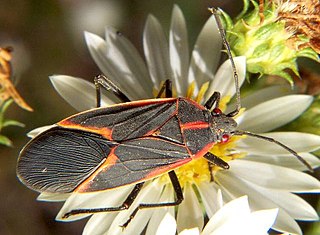
Serinethinae is a subfamily of the hemipteran family Rhopalidae, sometimes known as soapberry bugs. They are brightly colored seed-eaters, comprising three genera and about sixty-five species. These bugs are specialists on plants in the soapberry family (Sapindaceae), which includes maples, balloon vines, and soapberry trees, among others. Seeds of the plants are the main resource used by adults for reproduction and nymphs for growth and development. Their diversity is the result of an adaptive radiation on these plants, who have co-evolved defenses such as having their seeds contain cyanide, fly out, or be contained in hollow chambers.

Jadera haematoloma, the red-shouldered bug, goldenrain-tree bug or soapberry bug is a species of true bug that lives throughout the United States and south to northern South America. It feeds on seeds within the soapberry plant family, Sapindaceae, and is known to rapidly adapt to feeding on particular hosts. The species is often confused with boxelder bugs and lovebugs.
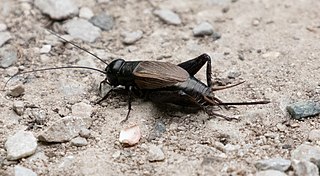
Gryllus veletis, commonly known as the spring field cricket, is abundant throughout eastern North America. G. veletis is a solitary, aggressive, omnivorous, burrow-inhabiting species of cricket. This species is commonly confused with Gryllus pennsylvanicus, as they inhabit the same geographical area. However, the two species are easily distinguished through examination of life history, ovipositor and behavioural differences. Predators of G. veletis include American toads, wild turkeys, red-tailed hawks, wolf spiders and red-backed salamanders.
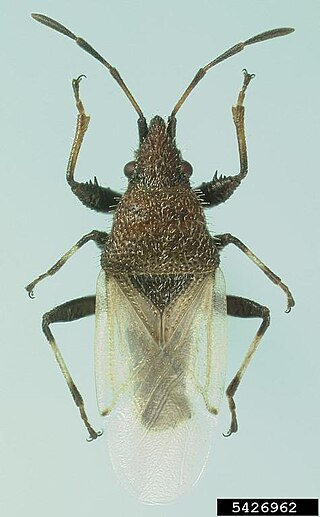
Oxycarenus hyalinipennis, common name cotton seed bug, is a species of plant bug belonging to the family Lygaeidae, subfamily Oxycareninae.

The Turkestan cockroach, Periplaneta lateralis, also known as the rusty red cockroach, red runner cockroach or simply rusty red, red runner, or lat, is a primarily outdoor-dwelling cockroach native to an area from northern Africa to Central Asia. Adults measure around 3 cm (1.2 in) in length. Adult males are a brownish orange or red, are slender, and have long, yellowish wings which allow it to attract females and to glide. Adult females are dark brown to black, with cream-colored markings on the shield and a cream-colored stripe edging its wings; they are broader than males, and have short vestigial wings. Nymphs are brown in front, black on the rear, and are wingless.
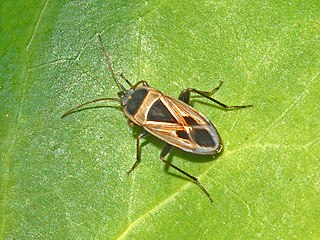
Xanthochilus saturnius, the Mediterranean seed bug, is a species of true bugs belonging to the family Rhyparochromidae.

Scantius aegyptius, the Mediterranean red bug, is a species of red bug in the family Pyrrhocoridae, that is a pest of plant species in the family Malvaceae.

Melanopleurus is a genus of seed bugs in the family Lygaeidae. There are more than 20 described species in the genus Melanopleurus.
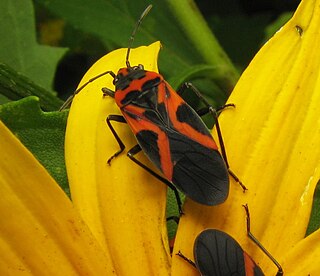
Lygaeus turcicus, the false milkweed bug, is a species of seed bug in the family Lygaeidae. It is found in Eastern North America.

Camptopus lateralis, common name broad-headed bug, is a species of true bugs of the family Alydidae, subfamily Alydinae.

Melacoryphus is a genus of seed bugs in the family Lygaeidae. There are about 11 described species in Melacoryphus, found in Central and North America.

Melacoryphus rubicollis is a species of seed bug in the family Lygaeidae, found in the southwestern United States and Mexico.
James Alexander Slater II is an American Entomologist, specializing in Heteroptera in the Family Lygaeidae, who erected the genus Melacoryphus. As son of entomologist James A. Slater, in order to avoid being confused with his father, he published as Alex Slater.



















